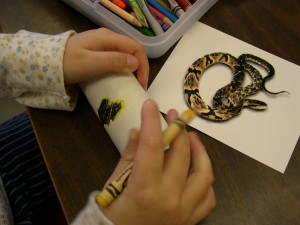Bradykinin
October 10, 2011 in Peptide
Wednesday, December 13th, 2006, Halifax, NS, 2nd graders captured a Jararaca snake in Brazil as they were transported to 1949 and the event of the discovery of Bradykinin, thanks to Stephanie Melanson (BSc DAL) and Emmelyne Pornillos (MDes NSCADU). All were intrigued as Emmelyne traced the silhouette of a volunteer student on a large piece of paper, and engaged answering Stephanie’s questions as the silhouette was filled in with various cartoon images (of germs, vaccines, white blood cells etc.) to create a visual story of the student’s immune system and its function as the body’s defense against illness. Bradykinin, the body’s sensitizer to inflammation, was clearly understood by one student, who described it as the equivalent of “the school alarm bell that rings in case of fire”. Seat belts were fastened and we traveled to São Paulo, Brazil, where we learned a little Portuguese and encountered the Bothrops Jararaca snake (Brazilian lancehead snake) and its poisonous venom with which Dr. Maurício Rocha e Silva and colleagues used to detect Bradykinin in animal blood plasma. Coloring and assembling those ever useful end-of-the-roll carton cylinders, the students created their own Jararaca as they listened to Brazilian Samba music.
Finishing our seventh MLP presentation in 2006, wIth five more peptides to go in 2007, we thanked team Bradykinin for amplifying the MLP signal in 2nd grade in Halifax.
Team Bradykinin, Emmelyne Pornillos (MDes NSCADU) and Stephanie Melanson (BSc DAL) creating a visual story of the immune system
Flying to Brazil…
Making a Jararaca
Team Bradykinin, Stephanie Melanson (BSc DAL) and Emmelyne Pornillos (MDes NSCADU) holding an MLP Jararaca.












